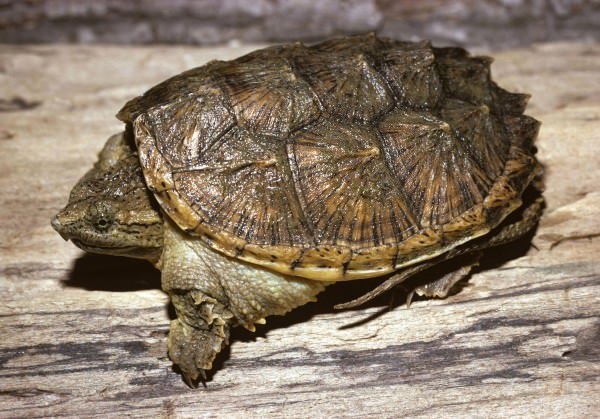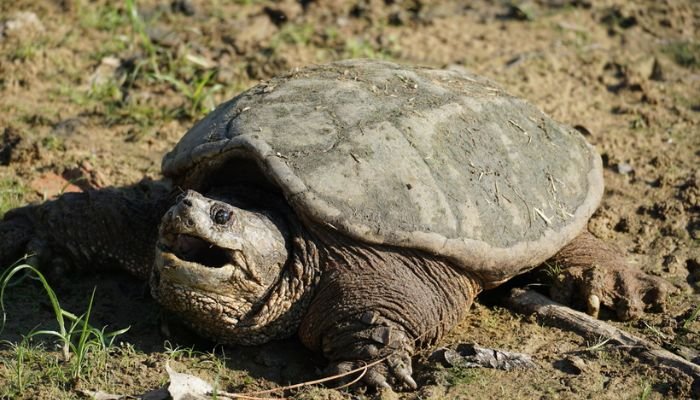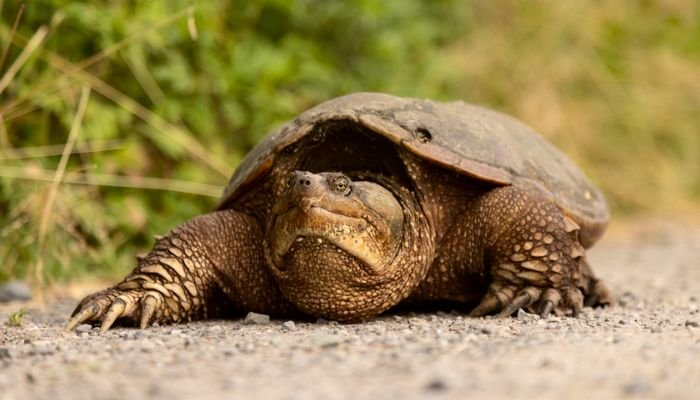
Snapping turtle The snapping turtle is a large, musculous freshwater turtle renowned for its powerful mandible and aggressive nature. These turtles of North America are known for their ability to rapidly bite and extend their necks when threatened. Snapping turtles are formidable predators with distinct shell morphologies. Nonetheless, during the reproductive season, they face threats from habitat degradation and vehicular collisions. The primary objectives of conservation efforts are preserving their habitats and implementing policies to ensure safe migration and reproduction.. Here are Snapping Turtle Guide on Food, Habitat, Size, Lifespan & Predators below-
Snapping turtle Stats in Table format
The stats are given below for Snapping turtle
| Reptiles List | Snapping turtle |
|---|---|
| Family | Chelydridae |
| Type | Turtle |
| Size | Large |
| Length | Snapping turtle: Up to 8-20 inches (20-50 cm) |
| Color | Snapping turtle: Typically has a brown or olive coloration. |
| Weight | Snapping turtle: Can weigh between 10 to 35 pounds.. |
| Lifespan | 30-40 years (or more) |
| Reproduction | Oviparous, lays eggs |
| Gestation Periods | The gestation period for snapping turtles is approximately 9 to 18 weeks. |
| Endangered Status | Least Concern (IUCN Red List) |
| Features | Powerful jaws, sharp beak-like mouth |
| Country & Areas | North America, Central America, and parts of South America. |
Snapping Turtle Natural Habitat and Distribution
In North America, the snapping turtle (Chelydra serpentina) inhabits a wide variety of aquatic ecosystems. It can be found throughout the southeastern regions of Canada, the United States, and perhaps Mexico. Snapping turtles favor ponds, lakes, marshes, and slow streams, all types of freshwater that move slowly or stay still. They have been spotted in both permanent and temporary water sources, and even in brackish water close to the coast.
Snapping turtles like locations with lots of aquatic vegetation, submerged logs, and rocky coasts for their natural environment. The turtles benefit from these qualities because they offer safe haven, sunbathing spots, and nesting grounds. Furthermore, they are able to partially bury themselves in the muddy bottoms of their environments, allowing them to successfully camouflage themselves and ambush food.
Snapping Turtle Physical Features and Adaptations
Here are some information about Snapping Turtle Physical Features and Adaptations
1. Body Structure
The snapping turtle is a huge and sturdy reptile. Their heads are larger than average, their upper shells (carapaces) are dark in color, and their plastron (bottom shells) are smaller than those of other turtle species. The word “snapping” comes from their aptly named powerful jaws, which feature sharp, hooked beaks. The tail is large and powerful, helping the animal propel itself through the water.
2. Coloration and Patterns
Snapping turtles’ skin coloration varies but is often black, rough, and mottled to blend in with the aquatic flora and muddy ground. The carapace can be marked with irregular marks and algae development, and can be a range of colors from brown to olive to black. Yellow or tan coloring can be seen on the plastron’s underside.
3. Defense Mechanisms
There are a number of defensive mechanisms present in snapping turtles. Their intimidating venom and razor-sharp beaks serve as a deterrence to would-be attackers. When threatened, they can use their long necks to snap their jaws violently and fight from a safe distance. In addition, like other turtles, they can partially retract their limbs into their shell for safety.
Snapping Turtle Diet and Feeding Habits
Here are some information about Snapping Turtle Diet and Feeding Habits
1. Diet Type
Snapping turtles ingest both plant and animal stuff, making them omnivores. This versatility aids in their capacity to thrive in a wide range of environments.
2. Preferred Food Sources
Their diet is quite varied, including of aquatic vegetation, insects, crustaceans, amphibians, fish, small animals, and even carrion. Snapping turtles are opportunistic feeders, meaning they will scavenge when given the chance.
3. Feeding Schedule
Snapping turtles are diurnal, meaning they are most active during the day, and they thrive during the warmer months when there is an abundance of food. During the colder winter months, they may become less active or even hibernate.

Snapping Turtle Housing and Enclosure Requirements
Here are some information about Snapping Turtle Housing and Enclosure Requirements
1. Terrarium Size and Setup
It’s important to remember that snapping turtles make excellent pets, but they need a lot of room and special lighting in their enclosures. A vast, specially constructed enclosure or pond is required for only one adult snapping turtle. A tank or pond of at least 200 gallons (757 liters) in volume is suggested for an adult. The more space you have, the better.
2. Substrate Options
Aquatic plants and soft substrates like sand or mud should be used to fill the enclosure. The turtle can then dig and burrow as it would in the wild. The turtle needs a place to dry off entirely on land, thus basking rocks or logs should be made available.
3. Temperature and Lighting
If you want to keep your snapping turtle healthy, you’ll need to provide it with a basking space and a heat lamp. The ideal temperature range for both the basking area and the water is 75-85 degrees Fahrenheit (24-29 degrees Celsius). For proper calcium metabolism and general well-being, UVB lighting from above is essential.
4. Humidity and Water Needs
The turtle needs plenty of room to swim around and be able to fully submerge in its habitat. Because of their untidy eating habits, snapping turtles pose a serious threat to water quality unless enough filtering is provided. The humidity level should be kept between moderate and high to ensure the turtle does not dry out.
Snapping Turtle Behaviour and Temperament
Here are some information about Snapping Turtle Behaviour and Temperament
1. Activity Levels
The majority of a snapping turtle’s life is spent submerged in water, and the animal often lives a solitary existence. When hungry, they will actively seek out food and are hence considered opportunistic predators. They move slowly on land, giving the impression that they are listless.
2. Social Behaviour
In the wild, snapping turtles are mainly solitary creatures, only coming together to mate a few times a year.
3. Handling and Taming
Care must be taken when handling snapping turtles. When threatened, they can become violent and use their formidable bite to defend themselves. Because of their unpredictable behavior, snapping turtles are best admired from a safe distance, therefore taming one is not recommended.
Snapping Turtle Breeding and Reproduction
Here are some information about Snapping Turtle Breeding and Reproduction
1. Mating and Courtship Rituals
The spring and early summer are prime mating seasons for snapping turtles. When a male is courting a female, he will approach her and attempt copulation if she is amenable. Water is a common venue for mating.
2. Incubation and Hatchlings
After mating, the female looks for a safe place to lay her eggs. For this, she may take a land trip. The female lays her eggs in a nest and lets them incubate on their own. The average incubation period is between 55 and 125 days. In late summer or early fall, hatchlings emerge from their nests and make their way to the water.
Snapping Turtle Common Health Issues and Veterinary Care
Here are some information about Snapping Turtle Common Health Issues and Veterinary Care
1. Respiratory Infections
Poor water quality, the wrong temperature, or not enough basking sites are common causes of respiratory illnesses in snapping turtles. Wheezing, nasal drainage, and fatigue are some of the symptoms. Immediately take your pet to the vet if you encounter any signs of breathing problems.
2. Parasites:
Internal and external parasites are a problem for snapping turtles, as they are for many other reptiles. A reptile vet can help diagnose and cure these conditions by routine exams of the feces.
3. Metabolic Bone Disease
Metabolic bone disease, which affects the turtle’s bones and overall health, can be caused by insufficient UVB exposure and poor calcium administration.

Importance of Regular Vet Check-ups
Snapping turtles as pets benefit greatly from regular visits to the vet. A trained vet can perform an in-depth examination, identify early symptoms of disease, offer advice on care and feeding, and screen for parasites. During these checkups, the veterinarian can also address any husbandry concerns you have and make any enclosure modifications your turtle may need.
Conclusion
Snapping turtles are found naturally and widely distributed over North America, and they do best in freshwater environments with plenty of aquatic vegetation. Their powerful jaws and distinct coloring serve as adaptations for survival and self-defense. Snapping turtles can adapt to a wide variety of diets since they eat a wide variety of foods. The housing and enclosure configurations for snapping turtles as pets must be designed to mirror their natural environment, including the right temperature, lighting, and humidity levels.
The social interactions of snapping turtles are minimal. Due to their aggressive temperament and powerful bite, they require special handling. Courtship rituals and nesting are crucial to the reproductive process, and young birds emerge from their mothers’ nests in late summer or early fall. Checkups with the vet are important for all pets because they allow you to keep an eye on their health and head off any problems before they become serious.
FAQs
Q: What is the family and Type of Snapping Turtle?
The Chelydridae family contains such reptiles as the Alligator Snapping Turtle (Macrochelys temminckii) and the Common Snapping Turtle (Chelydra serpentina).
Q: What is the average size of a Snapping Turtle?
Different species and sexes of snapping turtles have a wide variety of sizes. When fully grown, the shell of an alligator snapping turtle can measure anywhere from 16 to 32 inches (40 to 80 centimeters) in length, whereas that of a common snapping turtle is typically between 8 and 14 inches (20 and 36 centimeters).
Q: How long can a Snapping Turtle grow in size and length?
Snapping turtles continue developing throughout their lifetimes, albeit at a slower rate. The greatest size of a Common Snapping Turtle’s shell is between 18 and 20 inches (45 and 50 centimeters), and its usual lifespan is 30 to 40 years. There are reports of Alligator Snapping Turtles living to be 100 years old, with shells measuring 30 inches (75 cm) or more in length.
Q: What colors do Snapping Turtles come in?
The snapping turtle’s rough, dark shell is characteristic of the species. Their skin tones can range from brown to gray to even green, but most have a mottled appearance.
Q: How big can a Snapping Turtle get in weight?
The typical weight range for Common Snapping Turtles is 10–35 lb (4.5–16 kg). Due to their greater size, Alligator Snapping Turtles can weigh well over 100 kilograms (220 pounds).
Q: How long do Snapping Turtles live?
Snapping Turtles have a lengthy lifespan for reptiles. In the wild, the average lifespan of a common snapping turtle is between 30 and 40 years, but that of an Alligator snapping turtle can reach 80 to 100 years.
Q: How do Snapping Turtles give birth?
To answer your question, AA: Snapping Turtles are oviparous. When it’s time to lay eggs, female Snapping Turtles will leave the water and seek out dry land. They lay their eggs in a nest they’ve dug with their rear legs and then cover it up. The female then swims back into the ocean, leaving her eggs to incubate.
Q: How long is the gestation period for a Snapping Turtle?
AA: The term “gestation period” is used to describe the time it takes for a clutch of Snapping Turtle eggs to develop and hatch. It might be anywhere from 9 weeks to 18 weeks, depending on factors like average temperature.
Q: Is the Snapping Turtle endangered?
Snapping turtles are of varying conservation importance based on species and geographic location. They are a species of least concern in some regions, but their numbers have been dropping in others, thus they may be endangered there.
Q: What are the prey of Snapping Turtles?
AA: Snapping Turtles have a wide variety of foods in their diet and are opportunistic feeders. Most of their diet consists of things found in water, such as algae, insects, small fish, amphibians, crabs, and even carrion. They occasionally eat birds and small mammals as well.
Q: Do Snapping Turtles have any Predators?
Snapping Turtle hatchlings are vulnerable to many predators, including birds, fish, raccoons, and even larger turtles. The larger they get and the more defensive they become (by snapping), the less likely they are to be eaten. There aren’t many animals that would eat an adult Snapping Turtle in the wild, but humans still pose a threat through things like hunting and habitat loss.
Q: How Fast Does Snapping Turtles Move?
When it comes to land speed, snapping turtles do not have a stellar reputation. They favor aquatic habitats and move slowly for reptiles. Their top speed on land is between 0.3 and 0.8 kilometers per hour, or around 0.2 to 0.5 miles per hour.
Q. What is Bite Force of Snapping Turtle in PSI?
A Snapping Turtle’s bite may do a lot of damage. The force, which has been estimated to be between 1000 and 1500 psi, is high enough to do serious harm.
Q. Can we keep Snapping Turtles as pets?
The average pet owner is not a good candidate to care for a Snapping Turtle. Due to their defensive nature, they need specialist care, huge cages with access to water, and it can be difficult to handle them. Another consideration is that Snapping Turtles are not always permitted to own as pets due to local rules.
Q. Are Snapping Turtles good for pest control?
The populations of water insects, small fish, and other species are kept in check by snapping turtles, which play an important role in their ecology. They help keep rivers and streams clean by feasting on dead animals.
Q. Do Snapping Turtles require a UVB light source?
I hope you like reading on Snapping Turtle FAQ Guide on Food, Habitat, Size, Lifespan and Predators.
